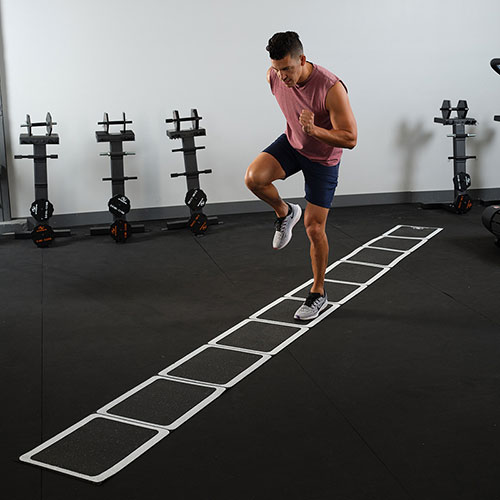Agility drills are the evidence of a peak offseason. With summer approaching, now is the time to get faster, quicker, and more agile. You can start by getting the best agility ladder for your needs.
Agility ladders are valuable tools for athletes and fitness enthusiasts looking to enhance their speed, agility, and overall performance. However, selecting the right one can significantly impact the effectiveness and longevity of your training sessions. Let’s explore three essential factors to consider when choosing an agility ladder: spacing, durability, and adjustability.
1. Spacing
The number of rungs on an agility ladder plays a crucial role in determining the intensity and variety of your workouts. After all, what’s the point of agility drills if you can’t actually move the way you want to? Not only do the number of rungs vary greatly depending on your chosen ladder, but the distance between rungs can change as well. Consider the following aspects:
– Length and Intensity
A ladder with more rungs allows for shorter step distances, demanding quicker footwork and enhancing agility. Longer ladders with fewer rungs are ideal for improving stride length and focusing on speed.
– Skill Level and Goals
If you’re a beginner, you may benefit from a ladder with fewer rungs to focus on foundational footwork. Advanced athletes might prefer a ladder with more rungs to challenge themselves more. This doesn’t necessarily mean that an advanced athlete has no use for a smaller, more simplistic ladder. Those can still be useful for maintaining quickness in short bursts.

2. Durability
Durability is a key consideration when choosing an agility ladder. If you’re not stepping or making contact with your ladder at least initially, you’re either way too good at this or you’re not challenging yourself enough. It’s probably the latter.
Agility ladders can be made of and assembled with a number of different materials. These are important to analyze before buying, or you’ll find yourself back online shopping for another in no time. Look for these aspects to ensure your ladder withstands rigorous training sessions:
– Material
Opt for high-quality materials such as nylon, which offer strength, durability, and resistance to wear and tear. Avoid ladders made of cheap plastic or low-grade materials.
– Construction
Pay attention to the ladder’s construction, including the attachment of rungs. Reinforced stitching and securely attached rungs will enhance durability and prevent them from becoming loose or detached.
3. Adjustability

The ability to adjust an agility ladder to meet your specific training needs is invaluable. Consider the following aspects of adjustability:
– Length and Width
Look for ladders with adjustable length and width options. This allows for versatility in training routines and enables you to adapt the ladder to different drills and exercises.
– Rung Spacing
Opt for a ladder with adjustable rung spacing. This feature allows you to modify the difficulty level, catering to both beginners and advanced athletes.
– Portability and Storage
Consider collapsible or foldable ladder options, making it convenient to transport and store. Compact storage features ensure it doesn’t take up much space in your gym bag or storage area.

Wrapping It Up
When selecting an agility ladder, paying attention to these three things can greatly enhance your training experience and results. Choose a ladder with the appropriate number of rungs to match your skill level and goals. Prioritize durability by selecting quality materials and sturdy construction. Lastly, opt for an adjustable ladder that offers flexibility in length, rung spacing, and portability. By considering these three factors, you’ll be equipped with the right agility ladder to maximize your training potential and achieve new benchmarks in your agility and quickness.

0 Comments